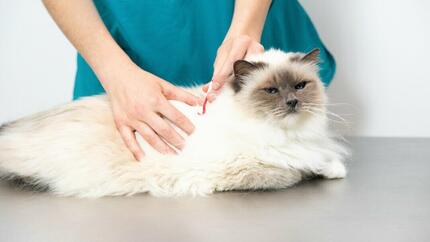

As well as lots of love and attention, it’s important to give your cat the best protection possible if they get lost or they go missing. Microchipping your cat, gives them the very best chance of being found and safely returned to you if they should wander off.
Why microchip?
As from 10th June 2024, it will be compulsory to have all cats from 20 weeks of age microchipped - although this can be done earlier. Not to do so could see you facing a fine of up to £500.
There are several benefits to permanently identifying your cat by microchipping. First of all, to be able to reunite you with your cat if they get lost, wander or stray, or are involved in an accident. Cat collars can be dangerous as they can get caught up on branches, fencing etc – and the safe ones (usually easy break or very lightly velcro fastened) are designed so that they can easily come off. Microchips are safe, easy to implant and effective - the perfect answer for feline ID.
There are all sorts of reasons why your cat might go missing. They might get spooked by something and run off, or maybe become disoriented or distracted in a new environment if, for example, you’ve just moved house.
As well as helping to reunite you with your lost pet, a cat microchip can also help if you ever get into a dispute with anyone about who the animal’s rightful owner is.
In addition, you can use a microchip to activate a microchip cat flap in your home. This can be linked to your cat or cat’s microchip and only let your feline into the house and so preventing ‘intruders’.
Plus, the microchip number can be linked to your cat’s veterinary notes, and of course if you decide to travel with your cat for any reason, a microchip will be needed as part of their travel requirements.
Read our article on traveling with your cat for more details.
What is microchipping?
Microchipping a cat is a simple and fast procedure that will permanently identify your cat. If your cat is found, a vet or animal shelter can scan your cat’s embedded microchip to find your details from the microchip database. It really is as simple as that!
How does microchipping work?
Simple and easy
It is possible (although not likely as most kittens are too small at that age) that your cat’s breeder has microchipped their kittens already, so check when you pick them up. Assuming not, you will have to arrange this before your kitten is 20 weeks old.
The microchip is about the size of a large grain of rice that is inserted under your cat’s skin.
The procedure is extremely quick and very easy – and the sensation is said to be similar to the feeling of a human having their ears pierced.
Once the microchip is in place, that’s it - your cat won’t ever know that it’s there!
The cat microchip has a unique 15-digit code, which is then logged in a national database along with your details including your name, address, and emergency telephone number. Remember that if you later move or change your contact details you must remember to update your records by contacting the microchip company. There is sometimes an admin fee applied to change your details, but some providers may waive this fee for the first change.
If your furry friend does wander off one day and is found by a kind stranger, all they have to do is hand them in to a shelter or veterinary surgery where the vet or warden will use a scanning device to see if your cat is microchipped. This scan is completely harmless and, much like a bar code on your shopping, your unique 15-digit code will be displayed along with details of the microchip database your cat is registered with. After security checks have been carried out, the microchip register will reveal your contact details to the vet or warden, and before long you and your cat will be reunited.
When should I get my cat microchipped?
From 10-12 weeks onwards
Depending on their breed and size, most cats can be microchipped from the age of 10-12 weeks onwards but must be done before 20 weeks of age. Be guided by your vet – and your own specific requirements – as the best time to do this.
It should be done before they go outside for the first time – and many people choose to do this while their kitten is under anaesthetic during neutering.
You should find that a kitten you adopt from an animal shelter will already be microchipped if they are old enough. Most rescue centres will microchip all cats that they rehome but if you rehome a cat that is not microchipped, and they are over 20 weeks old, you will have to arrange this within 21 days.
Some breeders also arrange microchipping of their kittens as part of their service to new owners.
How much does it cost to microchip a cat?
The cost of cat microchipping varies depending on the area where you live and whether it is done by a vet or a local charity. In most cases there’s a fixed cost to have the implant put in place, with no ongoing charges. Some charities do offer low-cost microchipping and you may find that your veterinary surgery runs occasional promotions. In the UK, an estimated usual cost (2024) is around £15-£30 – a small cost to ensure your cat can be returned to you if found.












